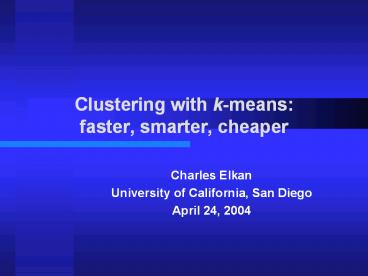Clustering with k-means: faster, smarter, cheaper PowerPoint PPT Presentation
Title: Clustering with k-means: faster, smarter, cheaper
1
Clustering with k-means faster, smarter,
cheaper
- Charles Elkan
- University of California, San Diego
- April 24, 2004
2
Clustering is difficult!
Source Patrick de Smet, University of Ghent
3
The standard k-means algorithm
- Input n points, distance function d(),
number k of clusters to find. - STEP NAME
- Start with k centers
- Compute d(each point x, each center c)
- For each x, find closest center c(x)
ALLOCATE - If no point has changed owner c(x), stop
- Each c ? mean of points owned by it
LOCATE - Repeat from 2
4
A typical k-means result
5
Observations
- Theorem If d() is Euclidean, then k-means
converges monotonically to a local minimum of
within-class squared distortion
?x d(c(x),x)2 - Many variants, complex history since 1956, over
100 papers per year currently - Iterative, related to expectation-maximization
(EM) - of iterations to converge grows slowly with n,
k, d - No accepted method exists to discover k.
6
We want to
- make the algorithm faster.
- find lower-cost local minima.
- (Finding the global optimum is NP-hard.)
- choose the correct k intelligently.
- With success at (1), we can try more alternatives
for (2). - With success at (2), comparisons for different k
are less likely to be misleading.
7
Standard initialization methods
- Forgy initialization choose k points at random
as starting center locations. - Random partitions divide the data points
randomly into k subsets. - Both these methods are bad.
- E. Forgy. Cluster analysis of multivariate data
Efficiency vs. interpretability of
classifications. Biometrics, 21(3)768, 1965.
8
Forgy initialization
9
k-means result
10
Smarter initialization
- The furthest first" algorithm (FF)
- Pick first center randomly.
- Next is the point furthest from the first center.
- Third is the point furthest from both previous
centers. - In general next center is argmaxx minc d(x,c)
- D. Hochbaum, D. Shmoys. A best possible heuristic
for the k-center problem, Mathematics of
Operations Research, 10(2)180-184, 1985.
11
Furthest-first initialization
FF
Furthest-first initialization
12
Subset furthest-first (SFF)
- FF finds outliers, by definition not good cluster
centers! - Can we choose points far apart and typical of the
dataset? - Idea A random sample includes many
representative points, but few outliers. - But How big should the random sample be?
- Lemma Given k equal-size sets and c gt1, with
high probability ck log k random points
intersect each set.
13
Subset furthest-first c 2
14
Comparing initialization methods
method mean std. dev. best worst
Forgy 218 193 29 2201
Furthest-first 247 59 139 426
Subset furthest-first 83 30 20 214
218 means 218 worse than the best clustering
known. Lower is better.
15
Goal Make k-means faster, but with same answer
- Allow any black-box d(),
- any initialization method.
- In later iterations, little movement of
centers. - Distance calculations use the most time.
- Geometrically, these are mostly redundant.
Source D. Pelleg.
16
- Lemma 1 Let x be a point, and let b and c be
centers. - If d(b,c) ? 2d(x,b) then d(x,c) ? d(x,b).
- Proof We know d(b,c) ? d(b,x) d(x,c). So
d(b,c) - d(x,b) ? d(x,c). Now d(b,c) -
d(x,b) ? 2d(x,b) - d(x,b) d(x,b).So d(x,b)
? d(x,c).
b
c
x
17
(No Transcript)
18
Beyond the triangle inequality
- Geometrically, the triangle inequality is a
coarse screen - Consider the 2-d case with all points on a line
- data point at (-4,0)
- center1 at x(0,0)
- center2 at x(4,0)
- Triangle inequality ineffective, even though our
safety margin is huge
19
Remembering the margins
- Idea when the triangle inequality fails, cache
the margin and refer to it in subsequent
iterations - Benefit a further 1.5X to 30X reduction over
Elkans already excellent result - Conclusion if distance calculations werent much
of a problem before, they really arent a problem
now - So what is the new botteneck?
20
Memory bandwidth is the current bottleneck
- Main loop reduces to
- 1) fetch previous margin
- 2) update per most recent centroid movement
- 3) compare against current best and swap if
needed - Most compares are favorable (no change results)
- Memory bandwidth requirement is one read and one
write per cell in an NxK margin array - Reducible to one read if we store margins as
deltas
21
Going parallel data partitioning
- Use a PRNG distribution of the points
- Avoids hotspots statically
- Besides N more compare loops running, we may also
get super-scalar benefit if our problem moves
from main memory to L2 or from L2 to L1
22
Misdirections trying to exploit the sparsity
- Full sorting
- Waterfall priority queues

